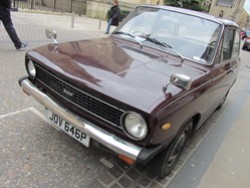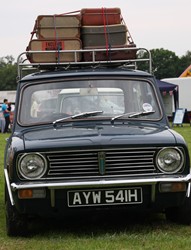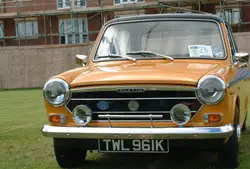Britain's best selling cars from the 70s

We spotted this Daff 66 in Oxford recently and started thinking about cars from the 70s. Daff was a rare Dutch import and the Daff 66 was made between 1972 and 1976. It eventually became the Volvo 66 before disappearing without trace. This one (pictured right) still seems to be doing a good job as a day to day car.
The Daff has some of the characteristics of cars from the 1970s with its boxy look and matt black grill.
Around 1970 automotive fashions changed. As women replaced mini skirts with midis and maxis, and men chucked out the Don Draper look in favour of flares and wide ties, cars changed just as significantly, on the outside at least.
Car makers ditched the chrome grills, the wood and leather interiors of the 60s and embraced American coke bottle styling, plastic fascias and matt black grills.
The UK's top four manufacturers all introduced new models leading up to and around 1970. The first of the new wave was the Ford Escort, launched in late 1967. It was a small car with neat American influenced body styling. Ford also launched the ground breaking Capri in 1969, which brought sports car styling to the average motorist. In 1970 there was a rash of new models: the Morris Marina; a completely restyled Vauxhall Viva; and the all new Hillman Avenger, remember those L shaped tail lights? In 1971 Ford launched the car that was to represent the 1970s, the Cortina Mk III.
Ford won the sales war and the Cortina was the best selling car of the decade, with the Escort in second place. BL made a series of mistakes, the worst of which was to replace their best selling Austin/Morris 1100/1300 range with the blob shaped Allegro. It eventually needed the State to intervene and save the company from bankruptcy.
The 70s also saw a greater proportion of foreign cars on the road. However, none of them made it into the top ten. The best selling foreign import was the Datsun Sunny, which was only the 19th best selling car of the decade.
These are the top ten best selling UK cars of the 70s.

1. Ford Cortina
Ford's stylists had their fingers firmly on the pulse of the 70s' car market. They replaced the neatly minimalist Cortina Mk II, driven by Michael Caine in Get Carter, with the glamorous Mk III in 1970.

If there was a car that summed up the mood of the early 70s perfectly it was the Cortina Mk III. The classic American inspired coke bottle styling was combined with plenty of chrome trim. The new Cortina was bigger and better than the outgoing Mk II.
Ford's graduated model range offered a huge choice of trim, style and engine size. You could choose from from L (basic), XL (more luxury), GT (sporty), GXL (luxurious) to the ultimate Cortina, the 2000E. Even the L looked stylish, but the upmarket GXL offered acres of simulated wood trim, glorious velour seats and a chrome trimmed black vinyl roof.

In 1976 Ford replaced the Cortina Mk III with the Mk IV. The glam rock era had faded by 1976 and Ford stylists gave the market something more sober, although the parent company's policy of sharing as much as possible between the UK Cortina and the German Ford Taunus may have also influenced the more prosaic styling.
The final facelift for the Cortina came in 1979. Ford sharpened up the style of the Mk IV with the similar looking Mk V, which nevertheless changed almost every body panel. The Cortina disappeared entirely in 1982 to make way for the Sierra, dubbed the 'jelly mould' car at the time.
See also Ford cars from the 1970s

2. Ford Escort
Ford also sold over one million Escorts in the 1970s. The Escort was introduced late in 1967 as a replacement for the popular Ford Anglia. Remember that backward sloping rear roofline?
The Escort continued the Anglia theme of a stylish body combined with basic, but reliable, mechanicals. However, Ford went one stage further with the Escort, as with the Cortina, they offered a range of basic saloons and some sporty and luxury models as well.
Style was all important to Ford's selling strategy and in 1975 they gave the Escort a new squared off body and models near the top of the range had square headlamps too. By 1979 you could choose from 1100, 1300, 1600, 1800 and 2000cc models. In 1980 the Escort was upgraded to a the Mk III for the new decade.

3. Mini
Although Alex Issigonis' masterpiece the Mini was eleven years old by 1970, it was still one of Britain's best selling cars. BL chose to drop the Austin and Morris labels and the car was now just called the 'Mini'.
In the1970s there was a basic range comprising a Mini 850 and a Mini 1000, with 850cc and 1000cc engines. BL offered a more upmarket version, the Clubman, with a squared off nose. There was an estate version with fake wood panels on the outside and a sports 1275 GT version.
Laurence Moss, the estate agent husband of man-eating Beverly in "Abigail's Party" drove a Mini, getting a new one every year. He claimed the design did alter, in reality BL made very few changes to the design throughout the 70s. By the end of the decade part of the charm of the car was that it had not changed.
The Mini continued in production for another two decades before being replaced by the new Mini in 2000.

4. Morris Marina
BL's executives originally planned the Marina as a replacement for the aging Morris Minor and a serious competitor for the Escort. Learning the lessons of the past they wanted to give it plenty of style and hired ex-Ford stylist, Roy Haynes.
Haynes wanted the two door version to appeal to the under thirty age group. He wanted the interior styling to be exotic and wild.
Somehow BL ended up producing a much bigger car than intended, even though it shared some of its mechanical heritage with the venerable Morris Minor. In reality the Marina sold considerably less well than expected. It achieved a creditable fourth position in sales in the 70s, but was not capable of rescuing BL from its financial troubles. Read more about the Morris Marina.

5. Vauxhall Viva
Vauxhall was like Ford, a British car maker with an American parent - General Motors. Like Ford they followed the same approach: a basic rugged car with an up to the minute body. The Viva had been around since 1963 and had already had one facelift. In 1970 Vauxhall revised it again.
The new Viva, called the HC, was still a small car and in the Escort class, nevertheless it looked wide, low and stylish.
Like Ford, Vauxhall offered a range of engines and options. At the top of the range was the sporty Firenza SL.
The Viva really was a car for the 70s. It starred in 1999 in the 1970s' revival comedy, 'The Grimleys' as Shane Titley's car. Vauxhall dropped it in 1979.
Read more: Vauxhall cars from the 1970s

6. Austin/Morris 1100/1300
The Austin/Morris 1100/1300 range was a top selling car in the 1960s. BL found it hard to find a replacement for it. So hard in fact that they failed to do so until 1973. So because of its continued strong sales in the first years of the 70s, the 1100/1300 finds itself at number six.
For the 70s there were some detail improvements and some great 70s' colours including purple and bright orange. Just like its cousins from the 60s, the 1100s and 1300s were spacious, reliable and mechanically simple.
If you fancied something a little sportier, there was the Austin 1300GT which was a tuned up version of the basic car with a black vinyl roof. BL replaced this best seller with the Allegro in 1973.
See also Austin cars from the 1970s

7. Austin Allegro
Where Ford got 70s' style right with the Cortina, BL got it wrong with the Allegro.
Launched in 1973, the Allegro was styled by internal stylist, Harris Mann. It certainly looked 70s. However, where the Cortina emphasised size and width, the Allegro was rounded and dumpy. There was a bizarre selection of different style front grilles complemented with rounded rectangular headlamps matched inside the car with a rounded square steering wheel, called a Quartic.

A range of engines sizes from 1100 to 1750cc, a rather stylish small estate and a posh Vanden Plas version with real wood facia, leather seats and picnic tables failed to impress buyers. Surprisingly BL failed to provide a hatchback version even though the Allegro shape suited it, and they had been making the hatchback Maxi since 1969.
The Allegro was not a great hit with the public. Whilst the 1100/1300 range was chalking up annual sales of 100,000+ units every year, the Allegro failed to achieve more than 65,000. This styling misjudgement certainly contributed to BL's collapse in 1975.
There was an unfortunate side effect to the 70s' style lettering on the boot: to some 'Austin Allegro' looked like 'Rustin Allegro'. The Austin All-aggro was another name for it.
When Austin-Rover dropped the Allegro range in 1982 to make room for the Maestro there were few sad faces.
8. Ford Capri

Ford advertised the Capri as the car you have always promised yourself. The Capri offered the motoring public something entirely new. It was almost a sports car, with a comfortable four-seater saloon cabin, gorgeous fastback styling and a price tag that the man in the street could afford.
Launched in 1969, the Capri sold well throughout the 70s. Like the Cortina, Ford offered a huge range of engines and trim levels. Like the Cortina, there were several styling revisions, but the basic look and personality remained the same.
At the top of the Capri range was the 3000E, which offered outstanding performance with a top speed of 122mph and 0-60mph in eight seconds. The brochure cooed about such refinements as reclining seats, an electric clock and push button radio. The prestige motoring experience was completed by a a steering wheel and gear knob covered in simulated leather.

9. Hillman Avenger
Rootes Group (Hillman, Singer, Sunbeam, Humber) launched the Hillman Avenger in 1970. It was a completely new car. The Avenger was mechanically unexciting, but offered a stylish new body with black grill with coke bottle styling and a sloping rear end.

The black grill was made from plastic. The Avenger also had some very distinctive L shaped rear a lamp clusters.
The Avenger was smaller than Rootes Group's Hillman Hunter and competed with the Escort and Viva. It sold steadily throughout the 1970s. There was a facelift in 1976 and it later became the Chrysler Avenger as the American parent began to assert itself more strongly.

10. Austin Maxi
The Austin Maxi could have been a world beater. It was one of the first hatch back cars, and it was one of the first mass-market cars to have a five-speed gear box. Partly designed by Alec Issigonis, it was spacious and handled well. However, the Maxi never lived up to expectations.
The original design, launched in 1969, was very plain looking and not liked by the public. The gearbox was awful and the 1500cc engine was not powerful enough for the car.
The Maxi had a major facelift in 1971. There was a new grill, a more attractive wood finish fascia and a new 1750cc engine. In this form it enjoyed modest sales throughout most of the 70s. People loved the practicality of the hatchback and with the seats folded down it was big enough to transport a double mattress and perfectly capable of carrying garden waste to the tip or a tent or two on holiday.
Reference
The ranking are derived from sales figures provide by bestsellingcarsblog.com.
Unfortunately, that site no longer makes the data freely available. If you want to check the data visit raycee1234.blogspot.com. This site does provide historical data on car sales free of charge.
By Steven Braggs, April 2013
Read more:
- Best selling cars of the 1960s in the UK
- Best selling cars of the 1980s in the UK
- Old cars in the 1970s UK


Comments
Yes, Commer and Karrier were the lorry divisions of the Rootes Group.